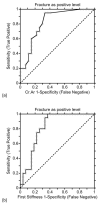Cancellous bone lamellae strongly affect microcrack propagation and apparent mechanical properties: separation of patients with osteoporotic fracture from normal controls using a 2D nonlinear finite element method (biomechanical stereology)
- PMID: 18378204
- PMCID: PMC2684698
- DOI: 10.1016/j.bone.2008.01.022
Cancellous bone lamellae strongly affect microcrack propagation and apparent mechanical properties: separation of patients with osteoporotic fracture from normal controls using a 2D nonlinear finite element method (biomechanical stereology)
Abstract
Biomechanical stereology is proposed as a two-dimensional (2D) finite element (FE) method to estimate the ability of bone tissue to sustain damage and to separate patients with osteoporotic fracture from normal controls. Briefly, 2D nonlinear compact tension FE models were created from quantitative back scattered electron images taken of iliac crest bone specimens collected from the individuals with or without osteoporotic fracture history. The effects of bone mineral microstructure on predicted bone fracture toughness and microcrack propagation were examined. The 2D FE models were used as surrogates for the real bone tissues. The calculated microcrack propagation results and bone mechanical properties were examined as surrogates for measurements from mechanical testing of actual specimens. The results for the 2D FE simulation separated patients with osteoporotic fracture from normal controls even though only the variability in tissue mineral microstructure was used to build the models. The models were deliberately created to ignore all differences in mean mineralization. Hence, the current results support the following hypotheses: (1) that material heterogeneity is important to the separation of patients with osteoporotic fracture from normal controls; and (2) that 2D nonlinear finite element modeling can produce surrogate mechanical parameters that separate patients with fracture from normal controls.
Figures




Similar articles
-
Postfailure modulus strongly affects microcracking and mechanical property change in human iliac cancellous bone: a study using a 2D nonlinear finite element method.J Biomech. 2008 Aug 28;41(12):2654-8. doi: 10.1016/j.jbiomech.2008.06.011. Epub 2008 Jul 30. J Biomech. 2008. PMID: 18672244
-
Damage initiation sites in osteoporotic and normal human cancellous bone.Bone. 2011 Mar 1;48(3):663-6. doi: 10.1016/j.bone.2010.11.009. Epub 2010 Nov 23. Bone. 2011. PMID: 21081188
-
The importance of intrinsic damage properties to bone fragility: a finite element study.J Biomech Eng. 2013 Jan;135(1):011004. doi: 10.1115/1.4023090. J Biomech Eng. 2013. PMID: 23363215
-
Finite Element-Based Mechanical Assessment of Bone Quality on the Basis of In Vivo Images.Curr Osteoporos Rep. 2016 Dec;14(6):374-385. doi: 10.1007/s11914-016-0335-y. Curr Osteoporos Rep. 2016. PMID: 27714581 Review.
-
Assessment of finite element models for prediction of osteoporotic fracture.J Mech Behav Biomed Mater. 2019 Sep;97:312-320. doi: 10.1016/j.jmbbm.2019.05.018. Epub 2019 May 11. J Mech Behav Biomed Mater. 2019. PMID: 31151004 Review.
Cited by
-
Biomechanical properties and microarchitecture parameters of trabecular bone are correlated with stochastic measures of 2D projection images.Bone. 2013 Oct;56(2):327-36. doi: 10.1016/j.bone.2013.05.023. Epub 2013 Jun 10. Bone. 2013. PMID: 23756232 Free PMC article.
-
Effects of mineral content on the fracture properties of equine cortical bone in double-notched beams.Bone. 2012 Jun;50(6):1275-80. doi: 10.1016/j.bone.2012.02.018. Epub 2012 Feb 25. Bone. 2012. PMID: 22394589 Free PMC article.
-
A quantitative analysis of bone lamellarity and bone collagen linearity induced by distinct dosing and frequencies of teriparatide administration in ovariectomized rats and monkeys.Microscopy (Oxf). 2021 Nov 24;70(6):498-509. doi: 10.1093/jmicro/dfab020. Microscopy (Oxf). 2021. PMID: 34100544 Free PMC article.
-
Random field assessment of nanoscopic inhomogeneity of bone.Bone. 2010 Dec;47(6):1080-4. doi: 10.1016/j.bone.2010.08.021. Epub 2010 Sep 15. Bone. 2010. PMID: 20817128 Free PMC article.
-
Multiscale contribution of bone tissue material property heterogeneity to trabecular bone mechanical behavior.J Biomech Eng. 2015 Jan;137(1):0108011-8. doi: 10.1115/1.4029046. J Biomech Eng. 2015. PMID: 25383615 Free PMC article. Review.
References
-
- Weiner S, Traub W. Bone structure: from angstroms to microns. Faseb Journal. 1992;6:879–885. - PubMed
-
- Bourne G. The Biochemistry and Physiology of Bone. 2. New York: Academic Press; 1972.
-
- Rho JY, Currey JD, Zioupos P, Pharr GM. The anisotropic Young's modulus of equine secondary osteons and interstitial bone determined by nanoindentation. Journal of Experimental Biology. 2001;204:1775–1781. - PubMed
-
- Rho JY, Zioupos P, Currey JD, Pharr GM. Microstructural elasticity and regional heterogeneity in human femoral bone of various ages examined by nano-indentation. Journal of Biomechanics. 2002;35:189–198. - PubMed
Publication types
MeSH terms
Grants and funding
LinkOut - more resources
Full Text Sources
Medical

